Serranía de Ronda travel information and video
Holiday information, facts, photos and video about Serranía de Ronda
Regions
Provinces
Coasts
Towns and areas
Regions
Provinces
Coasts
Towns and areas
Regions
Provinces
Coasts
Towns and areas
Featured holiday homes in Málaga province
Highlights of Serranía de Ronda
Highlights of Serranía de Ronda
Serrania de Ronda
The Serrania de Ronda is a range of mountains in the province of Malaga, the local region of the same name is dotted with picturesque white-washed villages (pueblos blancos). The most famous destination is the town of Ronda itself; one of the oldest towns in Spain, set 100 metres high, overlooking the Tajo Gorge, Ronda is one of the most popular tourist destinations in Andalusia.
Towns and Villages of Serrania de Ronda
The region of the Serrania de Ronda lies around 47 kilometres from San Pedro de Alcantara on the Costa del Sol. Head up through the winding roads into the mountains behind the coast and you come out to one of the most stunning natural landscapes, mountains ranges broken up by plains that stretch as far as the eye can see.
The town of Ronda dates back to Neolithic age and is one of the main cultural centres of Andalusia, or indeed throughout Spain. It’s the largest town in the Serrania de Ronda; although it still a relatively small town. There are lots of interesting sights and activities crammed in; the only problem is there are also lots of tourists visiting them. Ronda is the birthplace of bullfighting and home to one of the most important bull rings in Spain. There is a museum attached, where you can learn lots about the history of the sport.
The old town of Ronda has a distinctly Moorish influence; visit the restored Arabic Baths (Baños Arabes), and the Madragon Palace, which was originally home to the Moorish Kings, during their rule. Most visitors will initially head to the Nuevo Puente (New Bridge), which splits the town in two. Here you can take in the spectacular view across the plains and marvel at the the 100 metre drop to the River Guadalevin, that’s if you don’t suffer from vertigo!
Moving away from Ronda itself, the Serrania de Ronda is a fairly mountainous area, where you will find a some of the most beautiful pueblos blancos (white villages) of Andalusia. There are over 20 villages in total, but some of the most noteworthy include:
Grazalema: situated in the stunning natural park of the Sierra de Grazalema, nestled in the Sierra del Pinar mountains, Grazalema is a favourite destination for those looking to explore the natural beauty of Andalusia. There are some excellent local walking routes and it’s an excellent spot for bird watching. During the winter months it can snow and the scenery is majestic.
Gaucin: situated just hour an hour’s drive from the coast, Perched over 600 metres above sea level, Gaucín is a typical mountain village, affording spectacular views to the Rif Mountains in Africa and with the magnificent backdrop of the Serranía de Ronda. Gaucin has become a popular destination for foreign residents who are looking for a more natural and traditional lifestyle. For bird lovers it is typical to see kestrels and eagles flying through the turrets of the medieval fortress.
Algatocin: is a small village set in the Genil Valley, high up at 721 metres above sea-level. Algatocin boasts spectacular views to the Ronda mountains and the other white-washed villages in the local region. A typical Andalusian village, Algatocin with its winding, cobbled streets is a delight to explore. Of particular interest is the 16th century Virgen del Rosario church.
Juzcar: recently thrown into the limelight as it became the setting for the Smurfs movie in 2011, when they painted the whole town blue. Sony Pictures then offered to repaint the town white, but local residents decided to keep the buildings painted blue. It was estimated that tourist figures leaped from just 300 per year to 80,000 tourists in six months!
Genalguacil: If you are a lover of art and culture then head to Genalguacil during the first two weeks in August, when the town celebrates its annual art festival, Encuentros de Arte del Valle del Genal. Winning pieces are then displayed throughout the town after the event. Genalguacil is set within the Sierra Bermeja Natural Park and is ideal for rural and outdoor pursuits tourists, looking for an ideal spot for trekking and other outdoor activities.
Jubrique: this typical Andalusian village is said to have been founded in 711 by the Berbers, although the town as it is known today was not founded until the 15th century. Jubrique is has many cultural attractions; typical of these white-washed villages you will find the central point of the town is the church. In Jubrique you will also find fountains, hermitages, the old Lavar, the main washing area before electricity existed can be found at the bottom of the valley.
Cortes de la Frontera: Cortes de la Frontera affords a magnificent situation, overlooking the Guadiaro Valley, with the Serrania de Ronda mountains as the backdrop. Set at 623 metres above sea level, Cortes de la Frontera dates back to the 11th century and the town is exudes its ancient history. But probably the most notable reason for a visit is to indulge in the extensive cork tree woodland that surrounds the town. Stretching from the Guadiaro river to the boundary of the region of Cadiz, the cork production created a grand economy for Cortes de la Frontera during the 17th century.
These are just a few of the beautiful villages of the Serrania de Ronda. If you want to visit them all then head to: Alpandeire, Arriate, Atajate, Benadalid, Benalauria, Benarraba, Cartajima, Cortes de la Frontera, Farajan, Igualeja, Jimera de Libar, Montejaque, Parauta and Pujerra.
Natural beauty of the Serrania de Ronda
The Serrania de Ronda is a paradise for rural tourism, with the natural parks of the Sierra de Grazalema and Sierra de las Nieves; it’s an ideal destination for tourists looking to enjoy a walking, trekking or outdoor pursuits holiday, combined with a more traditional and cultural retreat, far away from the mass of tourism on the coast.
The region is also home to the Cueva de la Pileta, a Palaeolithic cave discovered in 1905 and dating back some 20,000 years. The caves shelter some of the most important cave art in Europe and are one of the few European cave systems open to visitors.
The ancient Roman town of Acinipo was founded during the Roman occupation and during the 1st century it was an important trading town, so important, in fact, that it was granted the right to mint its own coins. Now you can visit the amphitheatre which still stands; although it is the only evidence of the once great city.
Gastronomy of Serrania de Ronda
When in Rome… or when in Andalusia eat like the Andalusians. In the region of Serrania de Ronda the specialities are Jamon Serrano (ham on the bone) and Chorizo (spicy Spanish sausage) and they are truly delicious. Served on their own as a tapa, or in one of the many local rustic dishes, such as Potaje (chorizo, ham and bean stew).
Climate
As the altitude in most of the Serrania Ronda is higher, then it tends to be cooler in the winter and hotter in the summers, compared to the climate on the Costa del Sol.
The Serrania de Ronda is a range of mountains in the province of Malaga, the local region of the same name is dotted with picturesque white-washed villages (pueblos blancos). The most famous destination is the town of Ronda itself; one of the oldest towns in Spain, set 100 metres high, overlooking the Tajo Gorge, Ronda is one of the most popular tourist destinations in Andalusia.
Towns and Villages of Serrania de Ronda
The region of the Serrania de Ronda lies around 47 kilometres from San Pedro de Alcantara on the Costa del Sol. Head up through the winding roads into the mountains behind the coast and you come out to one of the most stunning natural landscapes, mountains ranges broken up by plains that stretch as far as the eye can see.
The town of Ronda dates back to Neolithic age and is one of the main cultural centres of Andalusia, or indeed throughout Spain. It’s the largest town in the Serrania de Ronda; although it still a relatively small town. There are lots of interesting sights and activities crammed in; the only problem is there are also lots of tourists visiting them. Ronda is the birthplace of bullfighting and home to one of the most important bull rings in Spain. There is a museum attached, where you can learn lots about the history of the sport.
The old town of Ronda has a distinctly Moorish influence; visit the restored Arabic Baths (Baños Arabes), and the Madragon Palace, which was originally home to the Moorish Kings, during their rule. Most visitors will initially head to the Nuevo Puente (New Bridge), which splits the town in two. Here you can take in the spectacular view across the plains and marvel at the the 100 metre drop to the River Guadalevin, that’s if you don’t suffer from vertigo!
Moving away from Ronda itself, the Serrania de Ronda is a fairly mountainous area, where you will find a some of the most beautiful pueblos blancos (white villages) of Andalusia. There are over 20 villages in total, but some of the most noteworthy include:
Grazalema: situated in the stunning natural park of the Sierra de Grazalema, nestled in the Sierra del Pinar mountains, Grazalema is a favourite destination for those looking to explore the natural beauty of Andalusia. There are some excellent local walking routes and it’s an excellent spot for bird watching. During the winter months it can snow and the scenery is majestic.
Gaucin: situated just hour an hour’s drive from the coast, Perched over 600 metres above sea level, Gaucín is a typical mountain village, affording spectacular views to the Rif Mountains in Africa and with the magnificent backdrop of the Serranía de Ronda. Gaucin has become a popular destination for foreign residents who are looking for a more natural and traditional lifestyle. For bird lovers it is typical to see kestrels and eagles flying through the turrets of the medieval fortress.
Algatocin: is a small village set in the Genil Valley, high up at 721 metres above sea-level. Algatocin boasts spectacular views to the Ronda mountains and the other white-washed villages in the local region. A typical Andalusian village, Algatocin with its winding, cobbled streets is a delight to explore. Of particular interest is the 16th century Virgen del Rosario church.
Juzcar: recently thrown into the limelight as it became the setting for the Smurfs movie in 2011, when they painted the whole town blue. Sony Pictures then offered to repaint the town white, but local residents decided to keep the buildings painted blue. It was estimated that tourist figures leaped from just 300 per year to 80,000 tourists in six months!
Genalguacil: If you are a lover of art and culture then head to Genalguacil during the first two weeks in August, when the town celebrates its annual art festival, Encuentros de Arte del Valle del Genal. Winning pieces are then displayed throughout the town after the event. Genalguacil is set within the Sierra Bermeja Natural Park and is ideal for rural and outdoor pursuits tourists, looking for an ideal spot for trekking and other outdoor activities.
Jubrique: this typical Andalusian village is said to have been founded in 711 by the Berbers, although the town as it is known today was not founded until the 15th century. Jubrique is has many cultural attractions; typical of these white-washed villages you will find the central point of the town is the church. In Jubrique you will also find fountains, hermitages, the old Lavar, the main washing area before electricity existed can be found at the bottom of the valley.
Cortes de la Frontera: Cortes de la Frontera affords a magnificent situation, overlooking the Guadiaro Valley, with the Serrania de Ronda mountains as the backdrop. Set at 623 metres above sea level, Cortes de la Frontera dates back to the 11th century and the town is exudes its ancient history. But probably the most notable reason for a visit is to indulge in the extensive cork tree woodland that surrounds the town. Stretching from the Guadiaro river to the boundary of the region of Cadiz, the cork production created a grand economy for Cortes de la Frontera during the 17th century.
These are just a few of the beautiful villages of the Serrania de Ronda. If you want to visit them all then head to: Alpandeire, Arriate, Atajate, Benadalid, Benalauria, Benarraba, Cartajima, Cortes de la Frontera, Farajan, Igualeja, Jimera de Libar, Montejaque, Parauta and Pujerra.
Natural beauty of the Serrania de Ronda
The Serrania de Ronda is a paradise for rural tourism, with the natural parks of the Sierra de Grazalema and Sierra de las Nieves; it’s an ideal destination for tourists looking to enjoy a walking, trekking or outdoor pursuits holiday, combined with a more traditional and cultural retreat, far away from the mass of tourism on the coast.
The region is also home to the Cueva de la Pileta, a Palaeolithic cave discovered in 1905 and dating back some 20,000 years. The caves shelter some of the most important cave art in Europe and are one of the few European cave systems open to visitors.
The ancient Roman town of Acinipo was founded during the Roman occupation and during the 1st century it was an important trading town, so important, in fact, that it was granted the right to mint its own coins. Now you can visit the amphitheatre which still stands; although it is the only evidence of the once great city.
Gastronomy of Serrania de Ronda
When in Rome… or when in Andalusia eat like the Andalusians. In the region of Serrania de Ronda the specialities are Jamon Serrano (ham on the bone) and Chorizo (spicy Spanish sausage) and they are truly delicious. Served on their own as a tapa, or in one of the many local rustic dishes, such as Potaje (chorizo, ham and bean stew).
Climate
As the altitude in most of the Serrania Ronda is higher, then it tends to be cooler in the winter and hotter in the summers, compared to the climate on the Costa del Sol.
Things to do while you are here
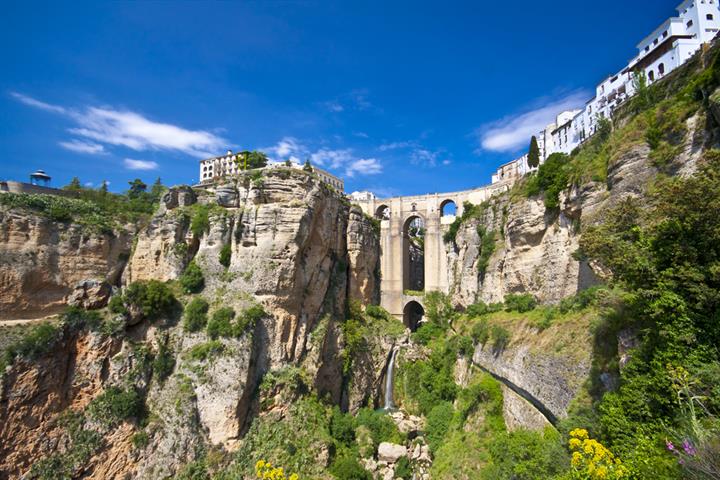
The 12 things you must see when visiting RondaRonda is one of Spain's most beautiful cities, this is what you have to see when visiting it. Ronda in full HD video. |
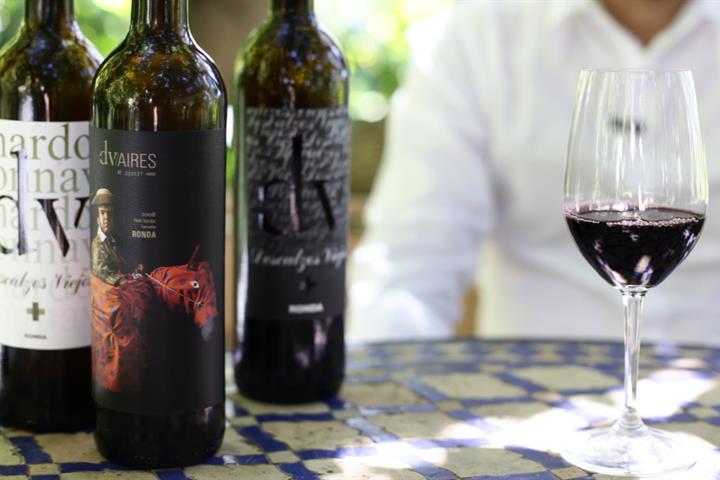
Descalzos Viejos: A private winery tour in RondaOur private tour of Descalzos Viejos, a 16th century monastery converted into a bodega, in the beautiful town of Ronda, Andalusia. |
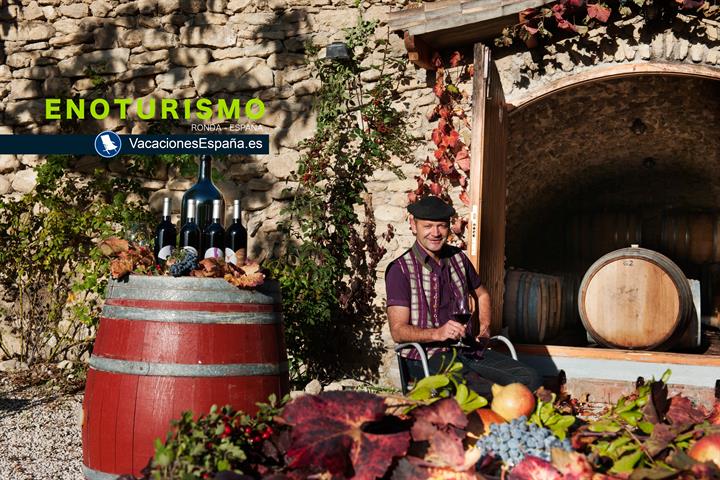
Enotourism: a wine route in RondaOne of the youngest wine regions on the national wine circuit, a visit is not to be missed. |
The road to RondaGetting to Ronda is just as good as being there. |
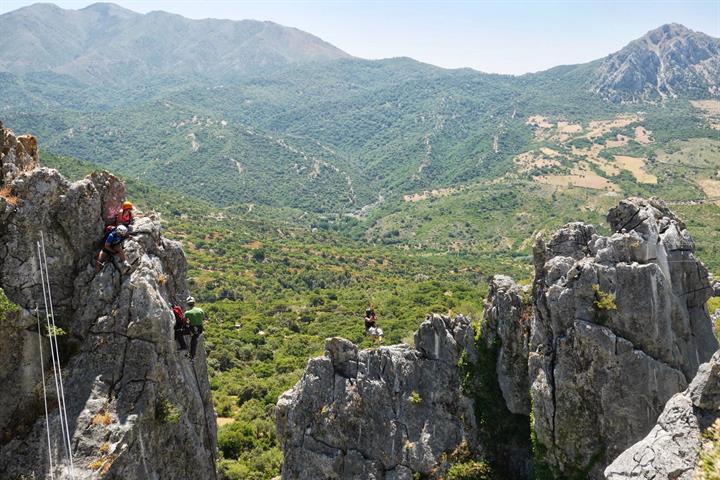
Via ferratas in AndaluciaExperience Andalucia from new heights. Via Ferrata routes are on the increase and provide an unforgettable day out. |
Two new Natural Monuments declared in AndalusiaRonda's gorge and the nearby Cueva de Gato cave complex have both been added to Andalusia's Natural Monuments list. |
Cueva del Gato, Benaoján, RondaIf looking for a fantastic and very easy spot to get to for a picnic and swim. The Cueva del Gato is just the place. |
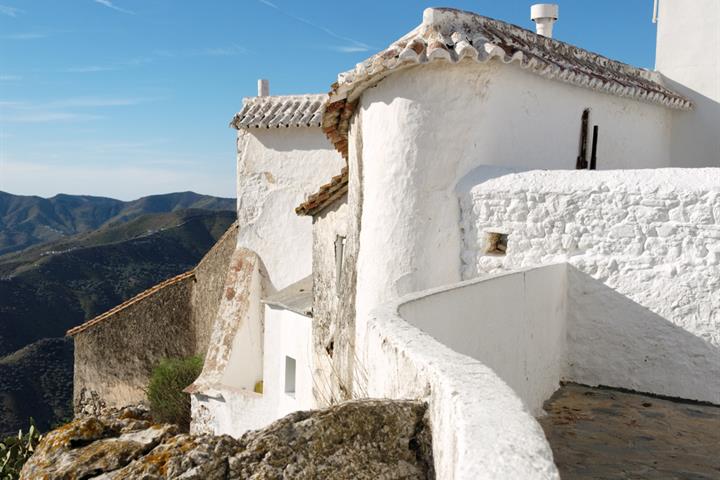
The Axarquia's Raisin Route, MalagaIf you are looking for a great day out and a drive through some of Malaga’s beautiful countryside then the raisin route is highly recommended. |

The 12 things you must see when visiting RondaRonda is one of Spain's most beautiful cities, this is what you have to see when visiting it. Ronda in full HD video. |

Descalzos Viejos: A private winery tour in RondaOur private tour of Descalzos Viejos, a 16th century monastery converted into a bodega, in the beautiful town of Ronda, Andalusia. |

Enotourism: a wine route in RondaOne of the youngest wine regions on the national wine circuit, a visit is not to be missed. |
The road to RondaGetting to Ronda is just as good as being there. |

Via ferratas in AndaluciaExperience Andalucia from new heights. Via Ferrata routes are on the increase and provide an unforgettable day out. |
Two new Natural Monuments declared in AndalusiaRonda's gorge and the nearby Cueva de Gato cave complex have both been added to Andalusia's Natural Monuments list. |
Cueva del Gato, Benaoján, RondaIf looking for a fantastic and very easy spot to get to for a picnic and swim. The Cueva del Gato is just the place. |

The Axarquia's Raisin Route, MalagaIf you are looking for a great day out and a drive through some of Malaga’s beautiful countryside then the raisin route is highly recommended. |

The 12 things you must see when visiting RondaRonda is one of Spain's most beautiful cities, this is what you have to see when visiting it. Ronda in full HD video. |

Descalzos Viejos: A private winery tour in RondaOur private tour of Descalzos Viejos, a 16th century monastery converted into a bodega, in the beautiful town of Ronda, Andalusia. |

Enotourism: a wine route in RondaOne of the youngest wine regions on the national wine circuit, a visit is not to be missed. |
The road to RondaGetting to Ronda is just as good as being there. |

Via ferratas in AndaluciaExperience Andalucia from new heights. Via Ferrata routes are on the increase and provide an unforgettable day out. |
Two new Natural Monuments declared in AndalusiaRonda's gorge and the nearby Cueva de Gato cave complex have both been added to Andalusia's Natural Monuments list. |
Cueva del Gato, Benaoján, RondaIf looking for a fantastic and very easy spot to get to for a picnic and swim. The Cueva del Gato is just the place. |

The Axarquia's Raisin Route, MalagaIf you are looking for a great day out and a drive through some of Malaga’s beautiful countryside then the raisin route is highly recommended. |